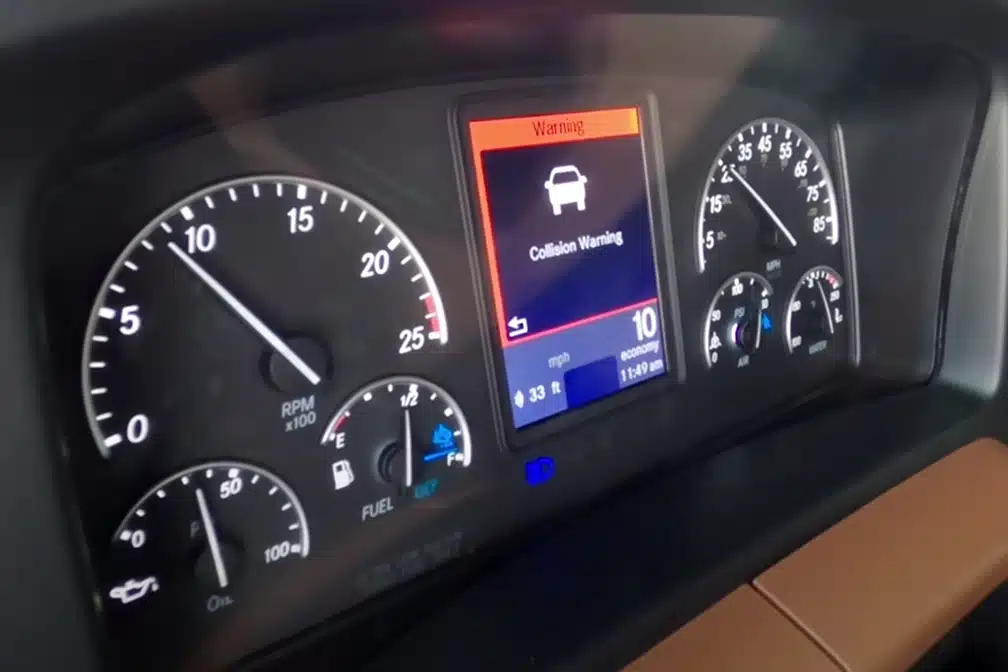OTR Truck Driver Safety Issues OTR drivers are confronted with safety challenges while out, on the road such as fatigue, distractions, changing weather conditions and other factors
More
May 19, 2024 4:05 pm

The recent proposal by the National Highway Traffic Safety Administration (NHTSA) and the Federal Motor Carrier Safety Administration (FMCSA) to mandate Automatic Emergency Braking (AEB) systems on heavy trucks has ignited a contentious debate within the trucking industry. This debate delves into a critical question: Can we enhance road safety without potentially compromising the safety and livelihoods of truckers themselves?
Unveiled in July, the proposal aims to require AEB systems and electronic stability control systems in new vehicles weighing over 10,000 pounds. While the primary goal is to bolster road safety, the Owner-Operator Independent Drivers Association (OOIDA) has voiced strong reservations about the mandate. One of their central concerns is the proposal’s perceived lack of attention to the crucial issue of false activations of AEB systems, which could potentially create more harm than good on the road.
An issue that OOIDA has underscored is the absence of comprehensive consultation with commercial motor vehicle drivers, the individuals most directly impacted by these systems. In their haste to meet congressional deadlines and comply with the bipartisan infrastructure law, the agencies may have overlooked the invaluable insights and experiences of truckers, who spend extensive hours behind the wheel and possess firsthand knowledge of the technology’s strengths and weaknesses.
The accounts of truckers themselves mirror OOIDA’s concerns regarding false activations of AEB systems. These professionals have shared their experiences with AEB technology, recounting alarming tales of false positives and unwarranted emergency braking. For instance, Michael Beyer highlighted the staggering frequency of false activations he encountered, ranging from incidents while overtaking other vehicles to unnerving scenarios on icy roads. Others have reported AEB systems engaging due to shadows or when driving under overpasses.
A recurring theme in these accounts is the fear that these false activations could lead to catastrophic accidents. For truckers, the prospect of their massive 80,000-pound rigs coming to an abrupt halt for no apparent reason is a safety concern that cannot be underestimated.
 Latest News:
Latest News:
In response to mounting concerns, NHTSA investigated false automatic braking events on specific truck models, including Freightliner and Western Star. While no accidents resulted from these false activations, NHTSA’s investigation aims to determine whether these incidents pose an unreasonable safety risk. This investigation has the potential to impact up to 250,000 trucks, underscoring the urgency of addressing these issues before implementing a mandate.
Despite the ongoing investigations, NHTSA and FMCSA remain committed to advancing the AEB mandate proposal. They have proposed two test scenarios to evaluate AEB system functionality, acknowledging that these tests alone cannot cover all real-world situations that may lead to false activations.
The 60-day public comment period on the AEB mandate proposal has concluded, amassing nearly 1,100 comments. Now, the agencies face the pivotal task of reviewing this substantial feedback and determining whether to proceed with a final rule. OOIDA’s impassioned plea is for the agencies to confront the false activation issues before imposing any mandate. They advocate for the adoption of additional safeguards, including more rigorous performance testing and stringent documentation requirements from manufacturers, to mitigate the risk of false AEB system activations.
The ongoing debate surrounding the AEB mandate for heavy trucks underscores the complexity of balancing safety mandates with the practical challenges faced by the trucking industry. While the primary objective of mandating AEB systems is to improve road safety, the concerns raised by OOIDA and experienced truckers must be seriously considered.
The potential dangers of false AEB system activations cannot be underestimated, and any mandate must comprehensively address these issues. Ultimately, the decisions made by NHTSA and FMCSA should prioritize the safety of all road users, including the dedicated truckers who crisscross the nation’s highways. A robust consultation process with industry professionals and a commitment to addressing their concerns is essential to prevent unintended safety risks on our roads while ensuring that the well-being and livelihoods of truckers are not compromised in the pursuit of greater safety.
For more information and articles from the trucking industry, follow us on Facebook or subscribe to our Truck Driver News newsletter.
OTR Truck Driver Safety Issues OTR drivers are confronted with safety challenges while out, on the road such as fatigue, distractions, changing weather conditions and other factors
MoreWhile historical practices, cost considerations, and regulatory factors offer context for the absence of reverse lights on van and reefer trailers, the benefits of implementing this vital
MoreTruck drivers often face numerous challenges, particularly related to road conditions. In this article, we will explore some of the reasons behind road condition problems encountered by
MoreThe American Trucking Associations (ATA) has expressed strong opposition to the Department of Justice's proposed rule of marijuana reclassification.
MoreConnell High School in Connell, Washington, has formally petitioned the FMCSA to allow students under 18 to obtain commercial learner's
MoreIn an effort to increase efficiency and sustainability in Trucking, Phillips Industries has launched their new, advanced, stick-on solar panels
MoreThe U.S. government is increasing scrutiny on Chinese companies that are potentially dodging tariffs by manufacturing Chinese EVs (electric vehicles)
MoreIn a legal battle that could reshape the trucking industry, 24 Republican states join to bring a lawsuit against the
More